Abstract
The sea surface temperature (SST) is an important factor and indicator of the sea water quality, with various ecological and anthropogenic implications. We used high-resolution satellite-derived SST data, in tandem with field observations and long-term meteorological data, to investigate the spatial and interannual SST variability over the Aegean, Ionian, and Cretan (AIC) Seas during the recent 14-year period (2008–2021). Increasing trends were identified for most of the sub-basins of the AIC Seas. The numbers and durations (days) of the marine heat waves (MHWs) have significantly increased, especially during the last quadrennial period (2018–2021). Changes have been detected in both the maximum and minimum values; however, the trend of the mean annual values is mainly associated with the interannual increases in the lowest values (weaker minima during the cold seasons). The interannual variability and the increasing positive trends of the air temperature are very similar to the SST variations, showing a 5-to-10-day lag between the seasonal time series of the two parameters for all regions; however, extreme atmospheric events (e.g., cold fronts or heat waves) have a more direct impact on the SST variability (zero lag). MHWs were more frequent over the northern Aegean Sea, especially in Thermaikos Gulf, which is characterized as a “hot spot” for MHWs. MHWs were rarer over the southern regions, especially over the southeastern Aegean and Cretan Seas. A stratified upper ocean, controlled by buoyant brackish plumes, such as the Black Sea Waters (BSW) in the northern Aegean, may increase the heat storage capacity of the surface water masses, contributing to the further warming of the ocean. This was the case in the summer of 2021, which was a unique year for the AIC Seas, and especially for the northern Aegean, which revealed the highest SST values among all the study years. The satellite-derived observations of the 2008–2021 period showed increasing trends for all coastal waters, strong trend slopes for most of the coasts of the northern Aegean and central Ionian Seas, and milder trend slopes in the eastern Aegean.
1. Introduction
The sea surface temperature (SST) is an important parameter of the natural environment that is strongly related to the earth’s climate and the hydrological cycle, mainly because of the exchanges between the atmosphere and the ocean [1]. The Aegean, Ionian and Cretan (AIC) Seas are located over the northeastern Mediterranean Sea. The variability of the temperature in the upper oceans of the AIC Seas is one of the major hydrological processes that affect the ecosystem and the productivity of the broader Mediterranean Sea [2,3]. The AIC Seas are surrounded by an extensive and topographically complicated coastline [4]. Therefore, the ocean temperature levels are affected by several environmental factors, such as the seasonal variations of the atmospheric conditions (heat fluxes, precipitation/evaporation rates, wind effects, and vertical mixing), the lateral conditions (river inputs, Black Sea Waters (BSW) input, exchanges with the broader Mediterranean), the circulation conditions (horizontal and vertical currents, upwelling/downwelling processes, eddies and gyres), and topography characteristics [5].
The AIC region is characterized by a typical Mediterranean climate, with a mean annual air temperature between 16 and 19.5 °C [5]. The prevailing atmospheric circulation patterns are primarily characterized by northerly winds. Specifically, during the cold period, northeasterly winds prevail in the northern Aegean Sea, and northerly winds prevail in its central and southern parts. Winds are mainly westerlies in the Ionian Sea. During the warm period, the Aegean Sea is predominated by the southward Etesian (or Meltemia) winds, which constitute one of the most persistent localized wind systems in the world [6,7]. This wind pattern is responsible for intense coastal upwelling over the eastern Aegean Sea, which induces a clear west–east SST gradient over the broader Aegean during the summer months [5,8,9,10,11].
Most of the previous observational and modeling efforts have focused on the SST variability of specific marine basins, such as the Aegean, the Ionian, etc., or on the broader Mediterranean Sea. Herein, we investigate the entire AIC domain, and identify the differences between the subregions, presented in Figure 1, over a recent 14-year period (2008–2021). Pisano et al. [12] showed that the AIC Seas, together with the Levantine Basin, revealed the highest increasing trends of SSTs (>0.05 °C/year) in the Mediterranean from 1982–2018. After 2007, especially, the Atlantic multidecadal oscillation (AMO) remained constant, on average, while the Mediterranean SSTs continued to increase. The first attempts to describe the SSTs of the AIC Seas were conducted in the early 20th century [4] by the corps of voluntary Marine Observers in the British Merchant Ships, the H.M. Ships (1900–1914 and 1921–1938), and the Danish oceanographical expeditions (1908–1910). This first effort showed significant differences in the mean levels between the Aegean (22–25 °C) and Ionian (24.5–26 °C) Seas [4]. Poulos et al. [5] investigated the seasonal and spatial distributions of the SST over the Aegean during a relatively old 6-year period (1988–1994), finding that the mean monthly SST varied from 8 °C in the north (northern Aegean: N Aegean) during winter, to up to 26 °C in the south during summer. The distribution of the Aegean is controlled by the air temperature and by the usually colder BSW and warmer Levantine Waters. Skliris et al. [13], on the basis of long-term satellite-derived (1985–2008) and in situ data (1950–2006), showed a small decreasing SST trend for the Aegean Sea until the early 1990s, and then a rapid surface warming right after, analogous to the temperature rise observed on the global ocean scale. These trends were related to climate change effects and to the variability of the large-scale atmospheric patterns. Gönülal [14], on the basis of in situ measurements at Imvros Island (N Aegean), which is located close to the BSW outflow, recorded that the SST increased annually by 0.035 °C/year, with a total increase of 1.6 °C from 1972 to 2018. The respective increasing trend of the entire Mediterranean Sea was larger (0.061 °C/year). The lower trend of the N Aegean is related to the influence of the cold BSW inflow. The S Aegean showed a slightly larger increasing trend with respect to the N Aegean for the 1985–2008 period [13]. The Aegean’s SST interannual and seasonal variabilities were also examined with satellite-derived observations taken from 2005–2008 by Topouzelis et al. (2015); as expected, the coldest month was February, and the hottest was July, while 2007 revealed the highest mean SST levels (~25 °C) among the study years, as is also stated by Mavrakis and Tsiros [15]. Topouzelis et al. [16] also stated that the spatial distribution of SSTs reveals a clear southward gradient, with minimum values around the Dardanelles Strait (BSW input), and maximum values over the Cretan Sea, in agreement with earlier observations discussed by Carapiperis et al. [4]. According to Shaltout and Omstedt [17], the entire Aegean Sea revealed a stronger increasing trend (0.038 °C/year) than the Ionian Sea (0.033 °C/year), revealing the highest annual trends among all the Mediterranean subregions for the period from 1982–2012.
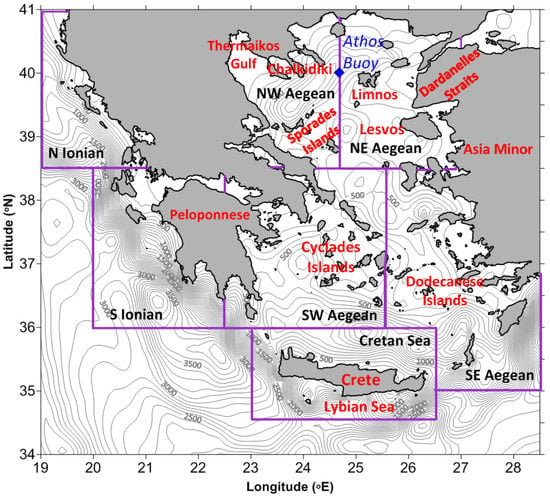
Figure 1.
Bathymetry of the study area divided into 7 subregions: northwestern (NW) Aegean, northeastern (NE) Aegean, southwestern (SW) Aegean, southeastern (SE) Aegean, the Cretan Sea, northern (N) Ionian, and southern (S) Ionian. The main topographical features described in the study are marked. The location of the Athos Buoy (blue, Poseidon System) is also marked. Each subregion is defined by the magenta lines and the neighboring land boundaries.
The findings of Inrahim et al. [18], between 1982 and 2020, have shown that over the Eastern Mediterranean, the marine heat wave (MHW) frequency increased by 1.2 events per decade, with a maximum significant MHW SST event (6.35 °C above the 90th SST climatology threshold) in 2020. They related this increase to a decrease in the wind stress, an increase in the air temperature, and to an increase in the mean sea level pressure. Some parts of the Aegean revealed longer durations of MHWs (~20 days) than the rest of the Mediterranean. The mean event duration ranged between 8 and 13 days during the 1982–2017 period, increasing the thermal stress-related mass mortalities of marine species [19]. Darmaraki et al. [20], on the basis of future emission scenarios, predicted 4 times more intense, and 42 times more severe MHW events by 2100.
In this study, we focus on the spatial and temporal SST variability during the most recent 14-year period (2008–2021), using high-resolution satellite-derived data and field observations. We discuss the spatial differences between seven subregions of the AIC Seas (Figure 1: NW Aegean, NE Aegean, SW Aegean, SE Aegean, Cretan Sea, N Ionian, and S Ionian). The motivation of the study is to identify the SST differences between the AIC subregions and the respective coastal waters during the last decade, which is potentially useful to the research on the implications between biochemical properties and sea temperature levels. The main goal is to detect the interannual SST trend of each sub-basin and their spatial differences, focusing also on the formation of MHWs and their interannual variability. We will also focus on the effects of the extreme atmospheric heat wave that occurred in the summer of 2021 (https://www.meteo.gr/, accessed on 20 November 2021) on the warming of the water masses, taking into account the prevailing environmental conditions (met-ocean). In addition, we will examine the interannual evolution of the MHWs over the entire study region in comparison to the extreme conditions of 2021. The along-shore variability and interannual trends of the entire coastal region, which is of great social and ecological importance, will also be discussed for the first time.
2. Data and Methods
The data used in the current study consist of satellite observations (temperature and ocean colors), atmospheric modeling data assimilated with observations, and ocean field observations covering the study period from 1 January 2008 to 15 November 2021. A summary of the data and their main characteristics is presented in Table 1.

Table 1.
Main characteristics (parameter, type, resolution, period, coverage area, source) of the data used in the study.
2.1. Satellite Observations
Two types of satellite data were used (Table 1). The first type includes the sea surface temperature (SST) set, distributed by the E.U. Copernicus Marine Service (https://www.copernicus.eu/, accessed on 20 November 2021), which covers the entire study period (2008–2021). The names of the SST datasets are the “Mediterranean Sea High Resolution and Ultra High Resolution Sea Surface Temperature Analysis” (SST_MED_SST_L4_NRT_OBSERVATIONS_010_004_c), and the “Black Sea High Resolution and Ultra High Resolution Sea Surface Temperature Analysis (SST_BS_SST_L4_NRT_OBSERVATIONS_010_006_c)”. The satellite-derived data consist of the daily mean gap-free (L4) horizontal fields [21] at a high spatial resolution (0.01°) over the AIC and Black Seas. Remotely sensed L4 SST datasets are operationally produced and distributed in near-real-time by the Consiglio Nazionale delle Ricerche—Gruppo di Oceanografia da Satellite (CNR-GOS). The accuracy of the Mediterranean satellite data is around 0.4 °C, higher than the Black Sea SST data, which evidence an error of around 0.6 °C [22]. Additional observations that have been collected by Sentinel-3B were integrated into the satellite data after 2019 [22] and enhanced the quality of the data used in this study. For the Mediterranean products, the validation results show a mean bias and a root mean square deviation (RMSD) of −0.078 ± 0.003 °C and 0.408 ± 0.003 °C, respectively. For the Black Sea products, the validation shows a mean bias and an RMSD of −0.23 ± 0.07 °C and 0.61 ± 0.07 °C, respectively. Further information about the datasets and their quality are discussed by Nardelli et al. [22]. The Mediterranean SST data were used to analyze the SST temporal and spatial variability, and to detect the MHWs over the AIC Seas. The Black Sea SST data were used to examine the SST ability to trace BSWs in the Aegean Sea.
The second type of satellite data extracts the chlorophyll-a (chl-a) concentrations in the sea water over the entire study region using ocean color information, distributed by the Copernicus Marine Service (L4 processing level, [23]). The ocean color data is a combined product collected by various sensors and satellites (MODIS-Aqua, NOAA-20-VIIRS, NPP-VIIRS, Sentinel3A-OLCI). The temporal and spatial resolution of the dataset is daily and 1 km, respectively. The chl-a concentrations were used for the detection of the brackish and highly productive BSW plume over the N Aegean region during 2021.
2.2. Atmoshperic Data
The meteorological conditions for our domain and study period were derived from the ERA5 hourly data on single levels distributed by the Copernicus Marine Service (Table 1). The ERA5 dataset is a fifth-generation ECMWF reanalysis that combines model data with observations (data assimilation), and that provides hourly estimates for a large number of atmospheric quantities. Herein, we used the meridional and zonal components of the wind at a height of 10 m above the sea surface to compute the variability of the wind speed over the AIC Seas during the 2008–2021 period. In addition, we also collected the air temperature at 2 m above the surface, which is produced by the interpolation between the lowest model level and the Earth’s surface, taking into account the atmospheric conditions. The spatial resolution of the atmospheric hourly fields was 0.25°.
2.3. Field Observations
Field observations, collected at the Athos Buoy (Figure 1) of the Poseidon System (Hellenic Center of Marine Research; https://poseidon.hcmr.gr/, accessed on 1 September 2021), were also used to define the physical ocean conditions and the vertical structure of the upper 20 m of the water column during the entire study period. In situ temperature and salinity hourly values, measured at 1 m and 20 m, and the field air temperature in dry bulb were analyzed to estimate the temperature variability, stratification frequency, the heat storage of the subsurface layers, as well as the BSW presence in the Aegean Sea.
The study adopts the definition proposed by Hobday et al. [24] to determine MHW events, on the basis of abrupt SST increases above a “climatologic” value (the baseline temperature) for a certain time period. To define a baseline temperature, Hobday et al. [24] proposed a period of 30 years, which is associated with the timescale variability of ocean drives (e.g., El Nino); however, sorted periods are also accepted. According to this definition, an MHW is defined as a “discrete and prolonged anomalously warm ocean-based event”. Hobday et al. [24] also pointed out that an MHW should be defined relative to a baseline period and a particular time of the year, from which the intensity, duration, and spatial extent of the MHW can be defined. This also means that MHWs are not just limited to the warmer months, since, for some biological applications, the consideration of heatwaves in colder months is essential. The term “discrete” implies that the MHW is an identifiable event, with clear start and end dates, and the term “prolonged” means that it has a duration of at least five days. Gaps between events of two days or less with a subsequent five days or more will be considered as a continuous event. “Anomalously warm” means that the water temperature is warm compared to the baseline temperature. The baseline temperature used in the present study, considering the limitation of the available data used (i.e., the period from 2008 to 2021), is defined by the seasonal (monthly) varying 90th percentile, derived from the 2008–2021 SST data in the resolution (0.01°) of the AIC domain. Moreover, the duration (the time between the start and end dates ≥5 days) was also computed for all detected MHW events.
3. Results
3.1. Interannual Variability of SST
The mean annual SST levels were averaged over the entire study region (19° E–28.5° E, 34° N–41° N), and for each subregion (Figure 1) separately (Figure 2a). The mean SST of the entire study region (black line in Figure 2a) reveals a clear increasing trend, derived from the annual means (0.49 °C/decade, Table 2), with a significantly high annual mean in 2021 (~20.9 °C, Figure 2a), while the respective annual mean was approximately 20 °C in 2008. The increasing trend is statistically significant on the basis of the Mann–Kendal [25,26] trend test (p value = 0.003 < 0.01: statistical significance level 99%, Table 2), with a small residual square error (RSE, Figure 3a). The annual 99th percentiles, representing the highest 1% of the SST values and averaged over the entire region, show a respective, but milder, interannual increase (Figure 2b) of about 0.35 °C/decade (Table 2). However, the linear trend derived from the yearly mean values is not statistically significant (p value = 0.157, Table 2), and is characterized by higher RSEs than the mean levels (Figure 3b).
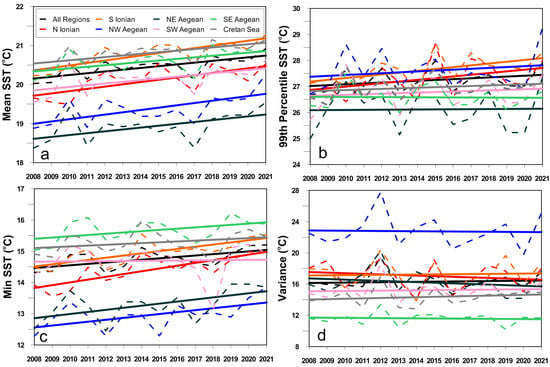
Figure 2.
Annual variability (dashed lines) and trends (continuous lines) of: (a) the mean sea surface temperature (SST; °C); (b) the 99th percentile of SST; (c) the minimum (min) SST; and (d) the variance, averaged over 8 regions (all regions: black; N Ionian: red; S Ionian: orange; NW Aegean: blue; NE Aegean: dark green; SW Aegean: purple; SE Aegean: light green; Cretan Sea: grey (Figure 1)), for the period 2008–2021. Note that the dataset of 2021 extends until 15 November.

Table 2.
Sen’s slopes (°C/year) and the respective MK statistical significance thresholds (p value), the upper (UpConf) and lower (LowConf) confidence intervals for the mean, the 99th percentiles (Perc), the minimums (Min), and the variances (Var), derived from yearly mean SST values, averaged over all regions (Figure 1) for the 2008–2021 period.
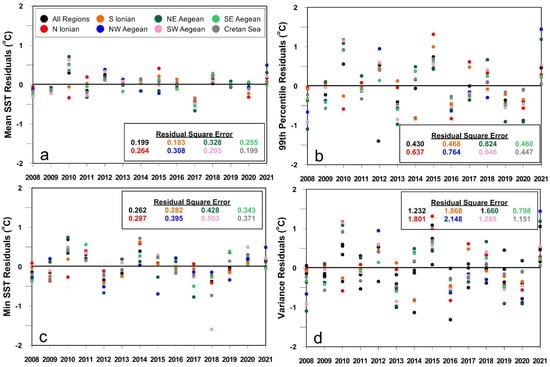
Figure 3.
Residuals derived between the observed mean annual, and the respective trend values of: (a) the mean sea surface temperature (SST; °C); (b) the 99th percentile of the SST; (c) the minimum (min) SST; and (d) the variance, averaged over 8 regions (all regions: black; N Ionian: red; S Ionian: orange; NW Aegean: blue; NE Aegean: dark green; SW Aegean: purple; SE Aegean: light green; Cretan Sea: grey (Figure 1)), for the period from 2008–2021. The residual square error (°C) for each trend is also shown.
The increasing trend of the mean annual minima (Figure 2c) is stronger (0.38 °C/decade, Table 2) and statistically significant (p value = 0.026 < 0.05: statistical significance level 95%, Table 2) in comparison to the trend of the maxima. The analysis of the residuals confirms the significance of the minima trend (RSEs < 0.5; Figure 3c). The 2021 minimum SST values are the highest among the entire study period, reaching the level of 15.2 °C, thus showing an increase of approximately 1 °C in comparison to 2008. This trend indicates that, during the cold season, when the lowest values usually occur, the winter–spring surface waters became warmer through the years. Even though summer–autumn (warm season) also revealed increased temperatures, the winter–spring values are the possible cause of the increasing mean values derived for the entire domain (Figure 2a). The variance of the annual values (Figure 2d) did not reveal a significant interannual trend, with almost zero Sen’s slopes (−0.04 °C/decade), large RSEs (>1, Figure 3d), a very high p value, and large upper and lower confidence intervals, based on the Mann–Kendal trend test (statistically insignificant, Table 2). These results show that the surface temperature difference between the cold (e.g., winter–spring) and warm waters (e.g., summer–autumn), which appear during the annual cycle, remained relatively constant throughout the 14-year study period, ranging around 16 °C.
The annual mean SST values were averaged over all the regions and revealed the narrowest confidence interval among the four parameters (mean, 99th percentile, min, and variance). Almost all of the values are aligned between the lowest and upper 95% intervals and along the linear trend (R2 = 0.5, Figure 4a). The uncertainty of the minima trend line is also low, showing a relatively small difference between the upper and lower confidence intervals (R2 = 0.35, Figure 4c).
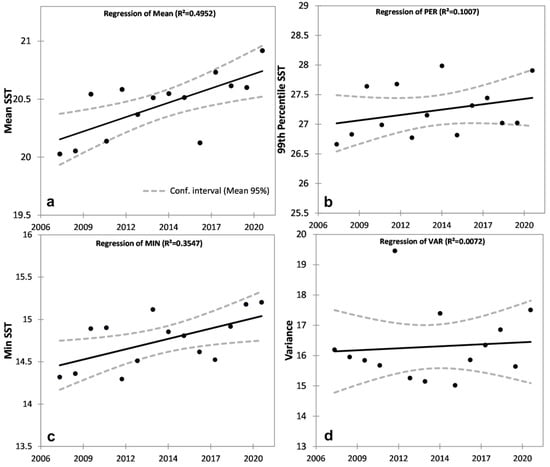
Figure 4.
Annual variability (dots) and trends (continuous black lines) of: (a) the mean sea surface temperature (SST; °C); (b) the 99th percentile (PER) of the SST; (c) the minimum (min) SST; and (d) the variance, averaged over all regions for the period 2008-2021. The confidence intervals (95%; grey dashed lines) for each case are shown.
All of the subregions show similar increasing trends to the mean annual values (Figure 2a), characterized by statistical significance (Table 2). The stronger trend appeared for the southern Ionian (0.69 °C/decade, with a p value = 0.0003), which revealed the smallest RSE (0.183 °C, Figure 3a), and the smallest difference between the upper and lower confidence intervals of the Sen’s slopes (Table 2). The mildest trend is derived for the Cretan Sea (0.45 °C/decade). The southern Ionian also revealed a statistically significant increasing trend of the lowest values (0.77 °C/decade) with the smallest upper and lower intervals, being the only region with a statistically significant increasing trend of the 99th percentiles (0.69 °C/decade). This implies that the increasing interannual trend of this basin is related to both cold and warm periods. The Ionian Sea, and especially the southern part, showed the stronger statistical significance among all the AIC regions (Table 2), in agreement with the results of Garcia-Monteiro et al. [27], who also computed lower p values for the Ionian Sea in comparison to the respective Aegean Sea trends. The highest annual 99th percentiles occurred in the northwestern Aegean during the first half of the study period (2008–2014, Figure 2b), while during the second half of the period, the highest values were derived from the northern Ionian. The highest 99th percentiles of 2021 were also computed for the northwestern Aegean (~29 °C, see also Section 3.5.1). The highest annual values of variance were computed for the northwestern Aegean (> 20 °C for all years, Figure 2d), due to the very low minimum SST values (< 13.5 °C, Figure 2c) and the high maxima (Figure 2b). The strong interannual increase in the lowest values of this region (0.60 °C/decade), and the respective smaller increase in the maxima (0.16 °C/decade), resulted in a small decrease in the variance throughout the study period (Figure 2d), though it is not statistically significant (Table 2). The general increasing trend of the minima (cold seasons), computed for the entire region, is mainly associated with the statistically significant trends of the Ionian Sea and the N Aegean Sea, where the highest Sen’s slopes occurred (0.6–1 °C/decade). Although the lowest values (minima) also increased for the other areas (the S Aegean Sea and the Cretan Sea), the slopes were smaller (0.2–0.5 °C/decade) and were not statistically significant (p values > 0.05, with high upper and lower confidence intervals, Table 2). The stronger increasing trend of the N Aegean (>0.60 °C/decade) is higher than the respective trends of the yearly mean values derived for the S Aegean (0.47 °C/decade for the SW Aegean, and 0.51 °C/decade for the SE Aegean). Skliris et al. [13] showed that, during the 1985–2008 period, the southern Aegean revealed an increasing trend similar to the trend we derived from the 2008–2021 period. However, Skliris et al. [13] presented a smaller trend for the N Aegean prior to 2008 (0.42 °C/decade), which is significantly lower than the trend derived from this study for the 2008–2021 period.
The spatial variability of the Sen’s slope, derived from the annual means over the entire AIC domain, is presented in Figure 5a. The highest statistically significant (p value < 0.05, Figure 5b) slopes are observed in parts of the N Aegean (> 0.75 °C/decade) and central and southern Ionian (> 0.65 °C/decade). The straits between the Peloponnesus and the northern Greek mainland are also characterized by strong SST trends. The eastern Aegean Sea and the SW Aegean Sea revealed the weakest trends, with very high p values. In particular, a distinctive region between Peloponnesus and Crete (~24° E–36° N) showed trends less than 0.1 °C/decade. Very low Sen’s slopes (< 0.35 °C/decade) were also computed for the area southeast of Crete.
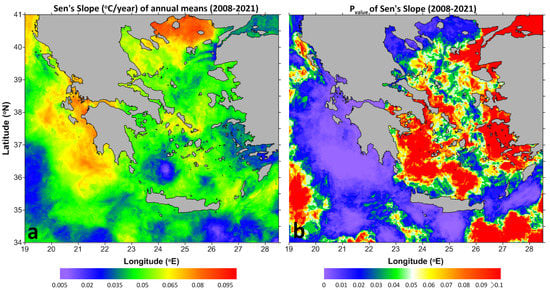
Figure 5.
Spatial distribution of: (a) the Sen’s slopes (°C/year) of annual sea surface temperature (SST) means; and (b) the respective MK statistical significance thresholds (p value), derived from the 2008–2021 period.
The interannual variability of the seasonal SST levels is presented in Table 3. The results confirm the strong increasing trends of the winter levels when the minimum values usually occur. The evolution of the mean winter SST over the entire AIC region is characterized by a high Sen’s slope (0.76 °C/decade), which is statistically significant (p value < 0.05), with narrow confidence intervals, especially for the lower interval (−0.191). Statistically significant increasing trends were also computed for the Ionian subregions (p value < 0.01). Although all seasons revealed increasing trends, they were smaller than the winter ones and the respective minimum values (Figure 2c) and were not statistically significant.

Table 3.
Sen’s slopes (°C/year) and the respective MK statistical significance thresholds (p value), and the upper (UpConf) and lower (LowConf) confidence intervals for the seasonal trends (winters, springs, summers, autumns), derived from the mean monthly SST values, averaged over all regions (Figure 1) for the 2008–2021 period.
3.2. Formation of Marine Heat Waves
The formation of marine heat waves (MHWs) was computed and analyzed for the entire study region, and for the whole time period. Both the annual number of MHW events and their total annual durations (days), which were averaged over the AIC domain, revealed an increasing trend during the 14-year period (Figure 6). The two trends are statistically significant (p value = 0.01), with relatively high coefficients of determination. The increase in the MHW days is 21.3 days/decade, and the respective increase in the MHW events is 1.7 events/decade, in agreement with the trend derived by Darmaraki et al. [19] for the whole Mediterranean Sea, using a different MHW definition and a longer period. Three peaks were computed in 2012, 2018, and 2019, respectively, with approximately four MHWs lasting around 30 to 35 days in total, constituting the high peaks of the mean values presented in Figure 2a. The fewest events occurred in 2008. The last four years (2018–2021) revealed a number of events and durations higher than all the previous periods, with the exception of 2012, when severe and long surface MHWs were observed in the whole Mediterranean basin [19].
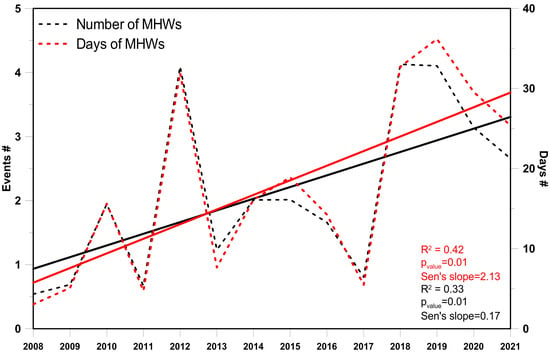
Figure 6.
Annual numbers (black) of events and total durations (days, red) of MHWs, averaged over the entire study domain from 2008 to 2021.
The spatial distribution of the total number of MHWs is presented in Figure 7. The largest number of MHWs was observed in the northern Aegean Sea (>35), where the accumulative period of all MHWs is more than 300 days. The entire northwestern region of the Aegean and the Thermaikos Gulf, especially, can be characterized as a “hot spot” of MHWs, affecting the respective coastal areas (see Section 3.5.1). Smaller areas with high numbers of MHW events, and total durations around 280 days, were also detected offshore the Ionian Sea. Both the Ionian Sea and the northwestern Aegean Sea revealed the highest annual 99th percentiles for all the years (Figure 2b). Smaller patches of high MHW numbers were also detected over the southern part of the SW Aegean (between Peloponnesus and Crete), in agreement with the strong SST trends (Figure 5a), but with relatively smaller numbers of total days (<270 days). The southeastern Aegean (Dodecanese Islands), and especially the southern Cretan Sea (Libyan Sea), revealed SST values closer to the seasonal variability (90th percentile, temperature baseline), with smaller numbers of events (<20) and durations (<200 days) of MHWs. The Cyclades Archipelago (southcentral Aegean) is also characterized by a low occurrence of MHWs. All the southern areas reveal the smallest increasing trends of the mean SSTs between all the study regions (0.46–0.57 °C/decade, Table 2). Similarly, the entire eastern Aegean Sea, except for the northeastern tip, revealed low numbers of MHWs.
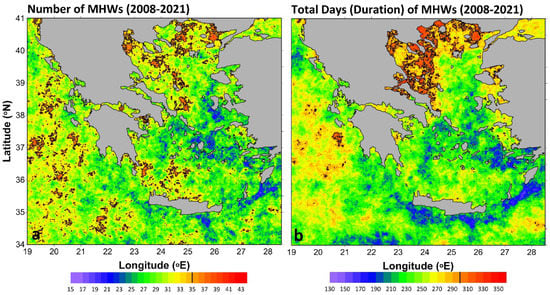
Figure 7.
Spatial distribution of the (a) total numbers of MHW events, and (b) durations (days), as derived from the entire 2008–2021 period. The threshold of 35 events and 300 days in total is marked with a black solid line.
3.3. Effects of Atmospheric Conditions on SST Variability
The mean monthly evolution of the SST (seasonal cycle removed), along with the yearly mean values (Figure 2a, Table 2), show statistically significant increasing trends for all regions (Figure 8). All of the trend p values are lower than 0.01, showing that the risk to accept the hypothesis that there is a trend in the monthly SST time series is less than 1%. The respective air temperature values (seasonal cycle removed) reveal a similar variability to the SST time series, leading to high positive correlation coefficients (Rp > 0.70) between the two parameters for all the study basins. All of the Pearson coefficients are also statistically significant (p values < 0.01).
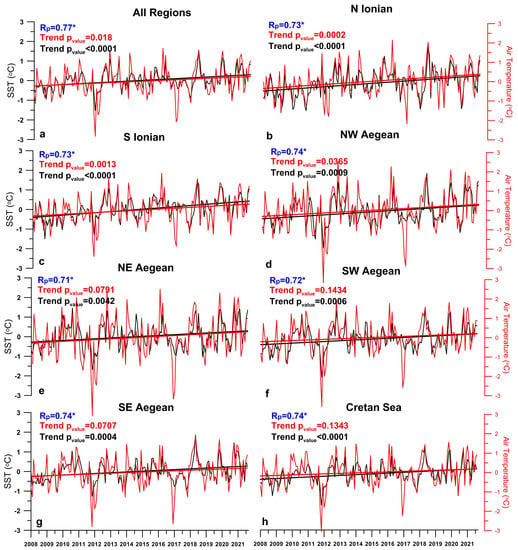
Figure 8.
Monthly evolution without the seasonal cycle of sea surface temperature (SST, black line, °C) and air temperature (red line, °C), averaged over: (a) all regions; (b) N Ionian; (c) S Ionian; (d) NW Aegean; (e) NE Aegean; (f) SW Aegean; (g) SE Aegean; and (h) Cretan Sea, over the 2008–2021 period. The linear trend, the respective trend p value, and the Pearson correlation coefficient (Rp) between the two time series are shown. One (*) and two (**) asterisks indicate statistically significant correlations of 99% and 95%, respectively.
The lag (in days) between the two parameters is almost zero. Once the seasonal cycle is removed, the interaction between them is direct, showing a high correlation (Rp = 0.65; Figure 9b). It is noted that this Pearson coefficient is derived from daily values to estimate the lag between the two time series, and, therefore, it is different from the one derived from the mean monthly values presented in Figure 8a (Rp = 0.77). On the contrary, the lag between the two variables is between 5 and 10 days if the seasonal cycle is included in the computation (Rp = 0.97, Figure 9a). The agreement between the two parameters confirms the known effect of the atmospheric temperature on the sea surface temporal and spatial evolutions, which varies between the regions because of other environmental factors, both atmospheric (e.g., wind speed, radiations) and oceanic (e.g., river plumes, lateral fluxes, vertical mixing, general circulation). A clear difference between the Aegean and Ionian Seas is detected in the relation between the air and sea temperatures. The north and south Ionian Seas reveal significant increasing trends for both the air and sea temperatures (all trend p values are lower than 0.01, Figure 8b,c). Even though the Aegean sub-basin events reveal statistically significant increasing trends as well, especially for the SST, they show higher p values, especially for the NE Aegean, and the correlation coefficient between the air and sea temperatures is the lowest among all the subregions (Rp = 0.71, Figure 8e).
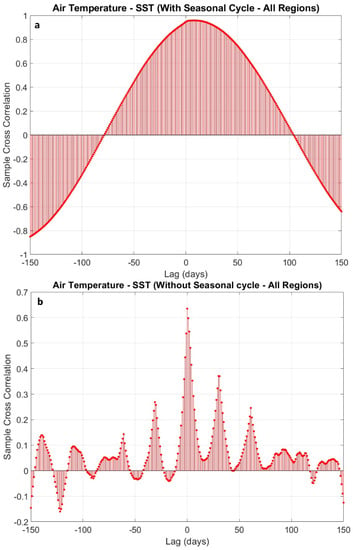
Figure 9.
Cross correlation between air temperature and sea surface temperature (SST) daily values, averaged over the entire study domain, (a) with the seasonal cycle, and (b) without the seasonal cycle. The y- and x-axes represent the Pearson correlation coefficients and the lag (days) between the two time series, respectively.
Similarly, the wind speed contributes to the variability of the SST, showing negative Pearson coefficients (countercorrelation) for all basins (Figure 10). High SST anomalies usually coincide with weak wind anomalies throughout the study period. Contrary to the air temperature evolution, the wind speed does not show any statistically significant trend; the trends of the SST are mainly related to the air temperature increasing trends (Figure 8). The northern Aegean revealed the lowest correlation coefficients between the wind speed and the SST anomalies, with smaller, or even nonstatistical, significances: Rp = −0.18, with a p value = 0.05 for the NE Aegean, and RP = −0.09, with a p value > 0.05 for the NW Aegean, respectively (instead of the 99% significance level that was computed for all other basins). More information about the factors affecting the temperature levels in the northern Aegean in relation to the later buoyant input from the Black Sea (BSW), besides the atmospheric ones, will be discussed in Section 3.5.2.
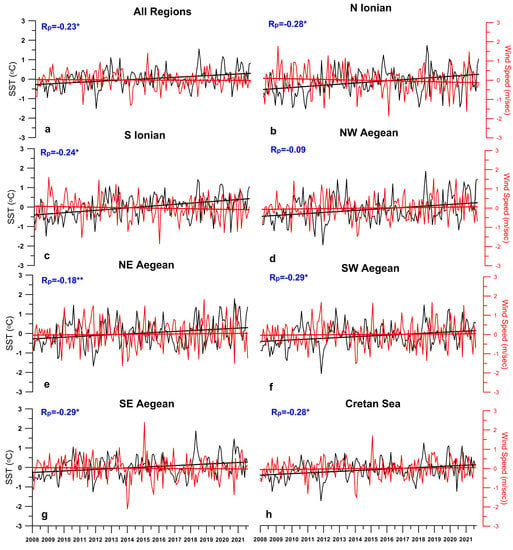
Figure 10.
Monthly evolutions, without the seasonal cycle, of the sea surface temperatures (SSTs, black line, °C) and wind speeds (red line, m/sec), averaged over: (a) all regions; (b) N Ionian; (c) S Ionian; (d) NW Aegean; (e) NE Aegean; (f) SW Aegean; (g) SE Aegean; and (h) the Cretan Sea, over the 2008–2021 period. The linear trends and the Pearson correlation coefficients (Rp) for each case are shown. One (*) and two (**) asterisks indicate statistically significant correlations of 99% and 95%, respectively.
The wind effect on the SST variability is stronger during the spring season, when the relation between the two parameters reveals the narrowest uncertainty confidence levels (95%) for all the subdomains of the IAC region (Figure 11). The spring coefficients of determination are the highest among all seasons (R2 > 0.45), reaching the value of 0.68 for the entire domain (Figure 8a). The weakest relation is computed for winters when the cold atmospheric conditions are more important for the SST levels. However, stronger wind velocities were observed during the winter months for all areas (>8 m/s), and they are associated with the lowest temperature levels (~16 °C) because of the intense wind-induced mixing. A different relation between the wind and surface temperatures is observed during the summer months for almost all areas; weaker winds are associated with lower temperature values, but also with very low coefficients of determination. Note that a very large uncertainty was computed for the NE Aegean (wide confidence intervals), especially during summer, due to the effect of the oceanic conditions, which will be discussed in Section 3.5.2.
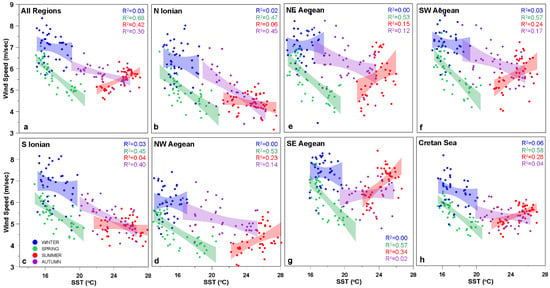
Figure 11.
Scatter diagrams of the mean monthly wind speeds (m/sec) and sea surface temperatures (SST; °C), averaged over: (a) all regions; (b) N Ionian; (c) S Ionian; (d) NW Aegean; (e) NE Aegean; (f) SW Aegean; (g) SE Aegean; and (h) the Cretan Sea. Each season (winter, spring, summer, autumn) consists of all the respective months of the entire 2008–2021 period, and they are marked with different colors. The 95% confidence intervals and the coefficients of determination (R2) for each case are also shown, with the same seasonal colors.
3.4. Variability and Trends in the Coastal Waters
The effects of the SST variability are more severe in the biochemical characteristics and the quality of the coastal waters than in the open sea because of the additional pressures from land-originating sources (e.g., nutrients and other pollutants due to drainage and river runoff). Another factor is the shallow and enclosed bathymetry of the coastal areas, which increases the ocean heat capacity and reduces the renewal of the water masses. Moreover, the coastal areas concentrate most of the human activities that are strongly related to the marine environment and its quality. Thus, understanding the temperature levels and trends is vital for the protection and management of the coastal zone.
The coastal distribution of the SST levels averaged over the 2008–2021 period is presented in Figure 12a. A clear north–south gradient, with a 20 °C threshold, is observed over the study region, with values lower than 20 °C for the northern and central Aegean coasts, and values higher than 20 °C along the Ionian, Peloponnese, S Aegean, and Cretan coastal regions. Southeastern Crete and the southern Dodecanese Archipelago, especially, reveal mean values higher than 22 °C (Figure 12a), and minimum values higher than 16 °C (Figure 12c).
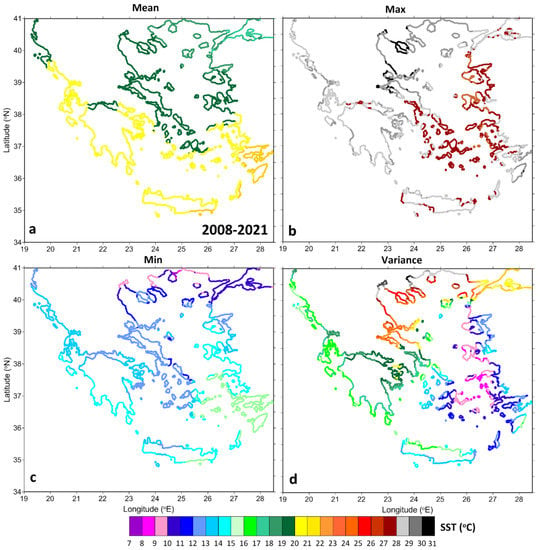
Figure 12.
Spatial distribution along the coastline of the study domain of the (a) mean sea surface temperature (SST); (b) the maximum (max) SST; (c) the minimum (min) SST; and (d) the variance of the SST, derived from the daily SST values of the study period (2008–2021).
Conversely, the Ionian Sea did not reveal such a gradient, showing mean SST values higher than 20 °C everywhere, except from the most northern coasts, which ranged between 19–20 °C (north of 39.5° N, Figure 12a). The levels of both the maximum (Figure 12b) and minimum SST values (Figure 12c) reveal a generally homogenous distribution along the Ionian coasts, resulting in a homogenous distribution of the variance (16 °C, Figure 12d). The Aegean north–south gradient is mainly related to the cold seasons, as derived from the distribution of the minimum SST values (Figure 12c), as observed in older findings [5]. The N Aegean coast revealed the lowest values of the entire study region (< 11 °C; Figure 12c). Another smaller, but apparent, gradient, decreasing from west to east, is detected between the NW and NE Aegean coasts. This west–east gradient is more profound in the maximum SST values over the entire region and is mainly related to the coastal upwelling and vertical advection of colder waters towards the surface (<28 °C, Figure 12b) over the eastern Aegean during the prevailing Etesian winds in the summer months. Relatively low maximum values were also measured over the Cyclades Archipelago (Figure 12b). The highest variances were found for the NW Aegean coasts, and especially for the Thermaikos Gulf (Figure 12d), where the highest maximum (> 31 °C) and lowest minimum (< 9 °C) levels of the entire coastline were detected. This result confirms the characterization of the Thermaikos Gulf as a “hot spot”, based on the numbers and durations of MHWs (Figure 7).
2021 was an exceptional year for the northern Aegean coasts, revealing the highest values among all the study years (Figure 13a). Generally, the highest values occurred during three distinctive years, depending on the sub-basin: 2021 for the northern Aegean; 2010 for the rest of the Aegean and Crete; and 2015 for the Ionian coastal areas, in agreement with the averaged values over the sub-basins presented in Figure 2. It is noted that the MHWs of 2021 mainly affected the northern Aegean coasts (Section 3.5). The distribution of the coldest years, with respect to the minimum SST values along the coastline, reveals a stronger spatial variability (Figure 13b). Notably, the coldest coastal waters of the Cyclades Archipelago were observed in 2018, while the lowest values of Crete were observed within two different years: 2018 in the west, and 2009 in the east. Similarly, 2009 was the coldest for the Ionian coasts and the southern Dodecanese Archipelago. The daily satellite observations of the entire 2008–2021 period also revealed increasing trends (positive slope coefficients of the linear trends, Figure 13d) for all the coastal areas, which are all statistically significant on the basis of the MK trend test of 99% (p value < 0.0001, Figure 13c). However, the slope of the trend varies between the coastal regions, with milder trends in the eastern Aegean, and stronger trends in the northern Aegean and central Ionian coasts. The only coastal region that revealed nonsignificant trends is the exit of the Dardanelles Strait, which is mainly affected by the brackish BSW that outflow into the Aegean Sea (Figure 13c). The results along the coastline are consistent with the general mean values of the sub-basins that showed higher Sen’s slopes for the Ionian and northern Aegean regions than for the southern Aegean and Cretan basins (Table 2, Figure 5).
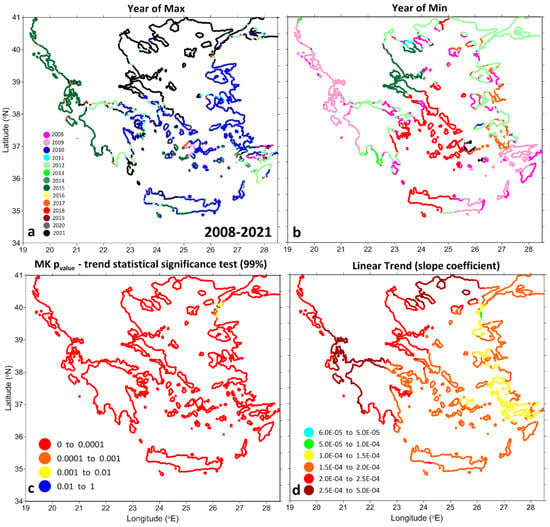
Figure 13.
Spatial distributions along the coastlines of the study domain of: (a) the year of the maximum (max) sea surface temperature (SST); (b) the year of the minimum (min) SST; (c) the p values of the Mann–Kendal statistical significance test (99%); and (d) the respective slope coefficients of the linear trends, derived from the daily SST values of the study period (2008–2021).
3.5. The Warm Year of 2021
The year of 2021 was characterized by successive atmospheric heat waves, starting on 28 July until 14 August (http://magazine.noa.gr/archives/4560, accessed on 31 December 2021). We examine the SST variability during this event, the formation of MHWs, mainly for the northern Aegean Sea, and the prevailing environmental conditions, both oceanic (e.g., BSW buoyant input) and atmospheric, on the basis of the available satellite and field observations.
3.5.1. Temperature Variability and MHWs
All the sub-basins of the AIC Seas reveal large SST anomalies between the July–August 2021 values and the monthly mean values derived from the previous period (Figure 14a). In addition, January–March of 2021 also revealed SST anomalies higher than the mean monthly values (Figure 14a), confirming the warmer waters of the cold period of 2021 (Figure 2c). April to June and September to November ranged around the mean values for almost all regions (<0.5 °C). Colder waters were observed, especially in the NE Aegean, in October 2021. The daily maximum SST values (90th percentile of 2021, red line in Figure 14b) were higher than the monthly 90th percentile derived from the entire study period (dashed line in Figure 14b) during winter and summer. The 90th percentile of 2021 reached 29 °C in early August, after a short-term increase of 1.5 °C at the end of July. The January and February 2021 90th percentiles were also higher than the respective seasonal values, by approximately 2 °C. Even the daily mean values of 2021 in January, February, and August followed the levels of the seasonal 90th percentile (Figure 14b, blue line in Figure 14b). The daily climatology, derived from the entire 2008–2021 period, and averaged over the entire AIC region (black line in Figure 14b), is lower than the respective levels of 2021 (blue line in Figure 14b), from January until mid-March, in June–July, and especially in early August (2 °C, Figure 14b). The daily SST levels for the rest of spring and autumn range around the climatological values. The most extreme values were computed for the N Aegean (NW and NE Aegean) for the winter and the summer period (Figure 14a). The NW Aegean SST anomaly was more than 1.5 °C during July and August, in agreement with the highest among all the basin 99th percentiles that were computed for this region (Figure 2b) and the northern coastal waters (Figure 13a). The smallest anomaly was also computed for the southernmost areas, the SE Aegean and Cretan Seas (Figure 14a).
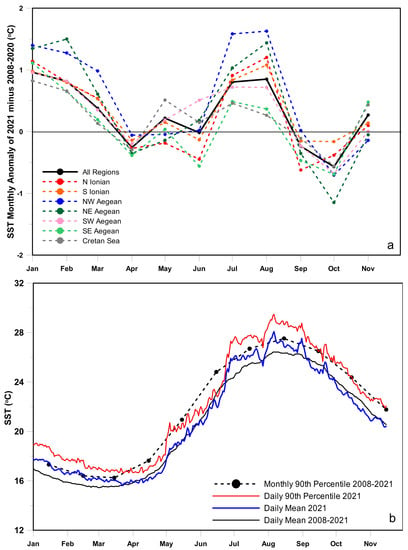
Figure 14.
(a) Monthly SST anomalies computed from the differences between the 2021 mean monthly means (January to August) and the respective mean monthly means of the entire 2008–2021 period, spatially averaged over each study subregion. (b) Daily 90th percentiles (red line) and means (blue line) of SSTs derived from the entire region for 2021. The black lines represent the mean monthly 90% percentiles of the SSTs (dashed with black dots) and the daily climatology (solid), derived from the 2008–2021 period, and averaged over the entire region. Note that the dataset of 2021 extends until 15 November.
The highest values of the N Aegean in the summer of 2021 are mainly related to the MHWs that were formed in the western part of this region, and especially in the broader Thermaikos Gulf (Figure 15b). The duration of the MHWs was more than 20 days in August 2021 and reached 30 days close to the western coasts of the central Gulf (40° N). Persistent MHWs (>20 days) also occurred in the Chalkidiki Peninsula, while the entire NW Aegean was characterized by MHWs with durations between 15 and 20 days. The rest of the N Aegean basin showed MHWs that lasted approximately 10–20 days. The northern part of NE Aegean, especially, revealed long MHW periods, confirming that the high SST levels of these regions (Figure 14a) were also characterized by long durations during the whole month. The NW region revealed shorter MHWs during June and July (< 15 days, Figure 15a). Generally, the MHWs that occurred in June–July 2021 were characterized by very small durations over the entire study domain (<10 days, Figure 15a). The western Ionian Sea (west of 20° E, and between 35° N to 39° N) also showed long MHWs during August 2021, which were mainly formed away from the coastal zone, where the durations were lower than 10 days, in agreement with the coastal SST variability presented in Figure 13. The southern Aegean and Cretan Seas did not reveal any MHWs during August 2021 (Figure 15b), in accordance with the SST levels derived for these regions (Figure 14a). These southern basins showed the mildest interannual SST trends among all the regions (Table 2, Figure 5), and the lowest number of MHW days for the entire study period (Figure 7b).
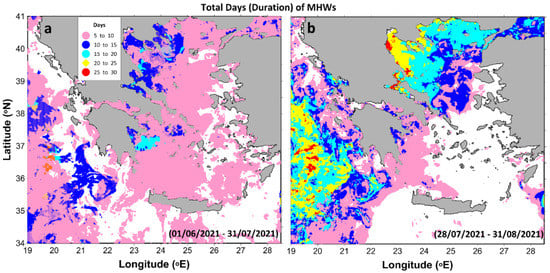
Figure 15.
Spatial distribution of the mean heat wave (MHW) durations (days) for: (a) June–July 2021, and (b) August 2021. The detection of the MHWs is based on the daily SSTs of 2021 and the baseline temperatures derived from the entire study period (2008–2021).
3.5.2. Environmental Conditions over the N Aegean
The main buoyant water mass over the N Aegean region is the BSW that flow through the upper layer of the Turkish Straits and exits into the Aegean from the Dardanelles. The BSW are characterized by low salinity levels [28] and high productivity [29], controlling not only the thermohaline functioning of the N Aegean [30], the dense water formation processes [31,32], and the coastal upwelling processes [9,10], but also the ecological character of the Aegean Sea [33,34,35]. These brackish BSW may occupy approximately the upper layers (0–50 m) of the water column, while the intermediate and deeper layers of the Aegean are mainly controlled by the intrusion of more saline Levantine waters from the south. While the SST is quite a good tracer of BSW in the Aegean Sea during cold seasons, in the summer, when the more severe MHWs usually occur, the shallow thermocline results in similar SSTs between the Marmara Sea and the N Aegean [33]. The large difference between the Aegean and Black Sea SST levels in winter–spring 2021 is minimized during summer (Figure 16a). The presence of the BSW is usually more profound in the summer months [28,36,37], following the hydrological cycle of the Black Sea [30]. Recent measurements show that the BSW outflow rates through the Dardanelles may reveal a very weak seasonal signal, with strong interannual variability [30]. Skliris et al. [13] dissociated the observed SST increase in the Aegean from the increased warming of the BSW inflow. In addition, Skliris et al. [8] argued that the nonseasonal variability of the Aegean’s SST is not affected by the SST variations in the BSW inflow. However, the summer of 2021 is a characteristic example, with very high SST levels, and the extended spreading of BSW over the N Aegean. Herein, we investigate the BSW contribution to the SST variability, and especially their relation to the increased number of MHWs over the northern regions in 2021.
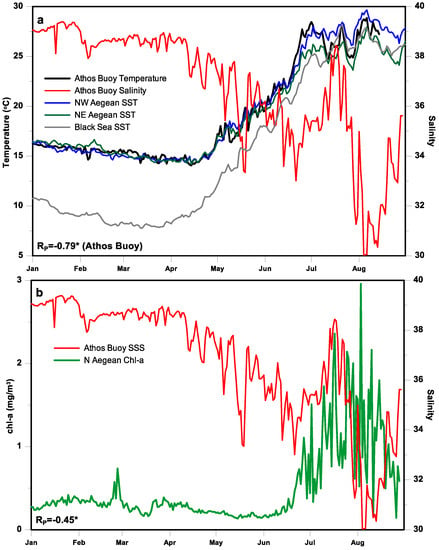
Figure 16.
Daily evolutions of: (a) temperature (black), and salinity (red), measured at a 1-m depth at the Athos Buoy, and satellite-derived sea surface temperatures (SSTs), averaged over the NW (blue), and the NE (green) Aegean, and the entire Black Sea (grey); and (b) salinity (red), measured at a 1-m depth at the Athos Buoy, and satellite-derived chlorophyll-a (chl-a) concentrations (green), averaged over the N Aegean (NW and NE combined), from January 2021 to August 2021. One (*) and two (**) asterisks indicate statistically significant correlations of 99% and 95%, respectively.
We used the field measurements collected at the Athos Buoy, located on the meridional boundary between the NE and NW Aegean Sea (Figure 1), to describe the temporal variation of the surface (1 m) and subsurface (20 m) vertical structures. The surface salinity ranged between 39 and 38 from January to April 2021, and began to decrease in May, revealing stronger daily variations, with strong salinity drops of 2 to 4 units (Figure 16a). A large salinity drop was observed in mid-June, and a more profound low appeared at the end of July, and especially in August (~30), associated with the presence of BSW over the central N Aegean region. One of the main circulation branches of BSW evolve along the Rim Current over the Athos deep basin and south of Chalkidiki Peninsula, carrying brackish waters westward and towards the NW Aegean [28]. During the same period (May to June), the surface temperature (1 m) increased, reaching 28 °C at the end of June. A short-term temperature drop was observed in July, when the salinity levels showed a respective peak (38). The surface temperatures reached their highest levels in early August, in agreement with the satellite-derived NW and NE Aegean SST values (Figure 16a), when the surface salinity revealed its lowest values (30). The Athos Buoy temperature variation is similar to the levels derived from the satellite data, showing that the location of this Poseidon System buoy is representative of the SST variability of the broader N Aegean region. The Pearson correlation coefficient between the salinity and temperature field time series of 2021 is high (RP = −0.79) and statistically significant, on the basis of the Mann–Kendal test (p value < 0.0001).
Chl-a is another variable, besides salinity, that can be used to detect the signal of BSW because of its high productivity, which is associated with the brackish plume [30]. The evolution of the satellite-derived chl-a concentrations is similar to the salinity variability, especially during the summer months, supporting the presence of BSW over the N Aegean (Figure 16b). A significant peak of the chl-a concentrations (~3 mg/m3) was measured when the lowest salinity levels (~30) occurred in the beginning of August. However, the chl-a distribution is also influenced by other environmental conditions that may control the levels of the primary productivity (e.g., river inputs, the seasonality of the atmospheric conditions, nutrient levels, ocean circulation, and vertical mixing). Therefore, the correlation coefficient between salinity and chl-a is not very high (RP = −0.45), but it is negative (countercorrelation) and statistically significant. Although there were periods (e.g., mid-July) where chl-a was increased in conjunction with high salinity levels (BSW absence), the extreme values (>2 mg/m3) usually coincide with periods of BSW presence (very low salinity, e.g., late July and early August).
The hypothesis is that this shallow and less saline BSW layer is subject to increased heating, resulting in higher SST levels. In a recent study, Amaya et al. [38] stated that a shallower mixed layer is associated with a smaller heat capacity, which could further intensify the SST warming in the summer, contributing to the formation of MHWs. They showed that the long-term shoaling of the mean mixed layer depth also has important implications for the magnitude of the SST extremes. We used the available salinity and temperature measurements of two layers at the Athos Buoy (1 and 20 m) to investigate the evolution of the upper ocean stratification characteristics during the entire study period (2008–2021, Figure 17). The nonseasonal temperature time series at the surface of the buoy revealed 12 significant peaks (higher than the 2 °C threshold, Figure 17b). The nonseasonality of the time series allows for the detection of the SST peaks during the annual cycle. The respective air temperature evolution is presented in Figure 17a. The SST peaks are not always correlated with the respective air temperature peaks in relation to the lower correlation coefficient (air–sea temperature), computed for the N Aegean regions in comparison to the rest of the AIC basins (Figure 8). The Brunt-Väisälä stratification frequency (N2, Equation (1)), derived from the physical properties of the upper 1-m and lower 20-m layers, represents the stratification characteristics between these two layers (Figure 17e):
where g is the gravitational acceleration (9.806 m/s2); ρ1 and ρ2 are the upper- and lower-layer densities, respectively; and Δz is set equal to 19 m in order to calculate the stratification frequency in the 1–20-m layer. The salinity levels of each layer (Figure 17c), their differences (ΔSalinity, Figure 17d), and the stratification frequencies (Figure 17e) provide concurrent information about the presence and the thickness of the BSW layer; large salinity differences and high N2 values are related to shallow barrier layers occupied by BSW.
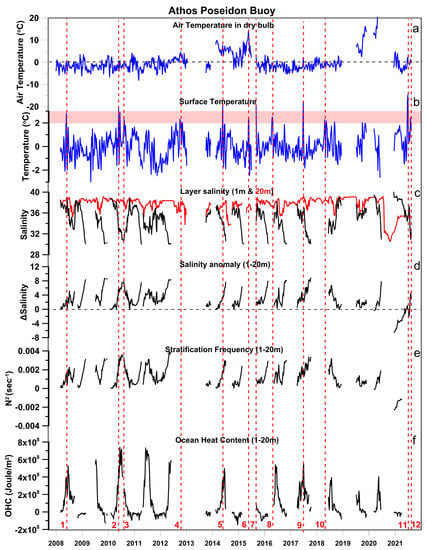
Figure 17.
Weekly means of: (a) air temperature in dry bulb; (b) sea temperature at 1 m; (c) salinity at 1 m (black) and salinity at 20 m (red); (d) salinity anomaly between the two layers (1 m and 20 m, ΔSalinity); (e) the Brunt-Väisälä stratification frequency (N2), derived between 1 and 20 m; and (f) the ocean heat content (OHC; Joule/m2) of the upper 20 m, derived from the Athos Buoy daily values, without the seasonal cycle. The red dashed lines represent 12 events when the surface temperature was higher than 2°C (red-shaded area in (b)).
During all 12 events, the surface salinity (when measured) showed very low values, while the deeper layer (20 m) was characterized by more saline waters (~38, Figure 17c). The ΔSalinity (Figure 17d) was high during these periods, resulting in the specific peaks of the stratification frequency (Figure 17e). The highest N2 values (0.0035 s−1, Figure 17e) occurred in the warm period of 2010 (Events 2 and 3), when very low surface (30), and high deeper (38) salinities were measured (Figure 17c). The respective SST peak was more than 3 °C during Event 2 and was more than 2 °C during Event 3. Similarly, the temperature increase in 2012 coincided with large ΔSalinity values and stratification frequencies, associated with a positive SST peak in September (Event 4). Event 5 is also related to increased N2 and very high temperature values (>3 °C). The stratification of the upper ocean increased in the summer of 2019 (Event 9), when the SST showed its second highest value of the entire period (Figure 17b). Our results confirm the hypothesis that the presence of a clear but shallow BSW layer contributes to the warming of the surface layer. The ocean heat content (OHC), which represents the energy stored in the ocean, was computed for the entire period when the thermohaline measurements in the two layers were available (Equation (2), Figure 17f).
where Q is the OHC per square meter for the ocean layer between h1 (1 m) and h2 (20 m) depths; ρz is the water density; Tz is the temperature; and Cp is the specific heat capacity of the seawater, as described in Landolt-Boernstein, New Series V [39]. The OHC revealed very high values during all 12 study events, with a large peak of 7 × 108 Joules/m2 in 2013 (Events 2 and 3). The lowest values occurred during periods of very weak stratification, strong mixing, and homogenous salinity between the upper and lower layers, with either small (deep BSW signal, e.g., August 2008, August 2009, and August 2016) or large (no BSW signal, winters of 2011, 2012, 2014, and 2016) values.
The correlation coefficient between the stratification frequency and the OHC is relatively high and positive (RP = 0.53, Figure 18a), and the variation of the values follows an increasing linear fit with the higher OHC levels associated with strong upper ocean stratification. The evolution of the N2 over this brackish-affected area is mainly determined by the salinity distribution, resulting in a respective good correlation between the salinity differences (ΔSalinity) and the OHC for the entire study period (Figure 18b). It is shown that the strong stratification, related to the buoyant barrier layer at the surface (BSW), may increase the heat storage capacity of the upper layers, contributing to the further warming of the surface water masses of the N Aegean.
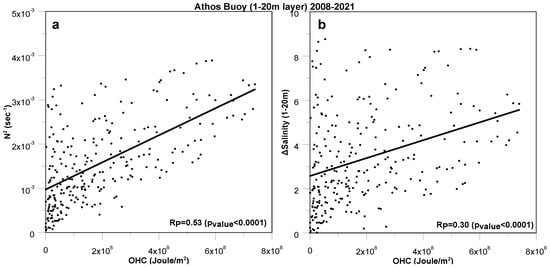
Figure 18.
Scatter diagram of ocean heat content (OHC; Joule/m2) of the upper 20 m, and (a) the Brunt-Väisälä stratification frequency (N2; sec-1); (b) salinity anomaly between the two layers (1 m and 20 m, ΔSalinity), derived from the Athos Buoy measurements during 2008–2021. The linear fit, the Pearson correlation coefficient (RP), and the respective p values of the Mann–Kendal significance test for each case is shown.
4. Summary and Discussion
High-resolution satellite-derived sea surface temperature (SST) data were analyzed to investigate the spatial and interannual SST variability over the Aegean, Ionian, and Cretan (AIC) Seas during the recent 14-year period (2008–2021). The high resolution and the good quality of the satellite observations, especially after 2019 [22], allowed for the detailed investigation of the SST levels, both over offshore and coastal waters. Comparisons with field measurements during the marine heat waves of the summer of 2021 confirmed the good quality of the satellite data, where both datasets (satellite and in situ) described in detail the daily variations and the extreme peaks of temperature.
We found a general increasing trend of 0.49 °C/decade over the AIC Seas, with stronger local gradients over the southern Ionian and northern Aegean Seas (>0.60 °C/decade), as was also reported by Mohamed et al. [40]. The general trend is slightly higher than the trend of the broader eastern Mediterranean basin (0.40 °C/decade), derived from a spatially coarser (0.25°) dataset [41]. Some parts of the northern Aegean, those closer to the northern shelves, revealed the highest statistically significant Sen’s slopes (> 0.75 °C/decade). Mohamed and Skiris [41] also computed stronger trends over the northern part of the Aegean Sea. The strong increasing trends of the northern Aegean are higher than the ones computed for the southern Aegean (0.47 °C/decade for SW Aegean, and 0.51 °C/decade for SE Aegean). García-Monteiro et al. [27], on the basis of a longer dataset from MODIS (2003–2019), showed a strong increasing trend for the broader Aegean Sea (0.60 °C/decade), in line with our results for the northern part of the region. The strongest trend slopes were computed east of the Chalkidiki Peninsula and along the respective coastal areas, in agreement with Garcia-Monteiro et al. [27]. The southern Aegean revealed similar increasing trends to a previous observational period (1985–2008, [13]). However, prior to 2008, the same observations showed significantly smaller increasing trends (0.42 °C/decade, [13]) for the northern Aegean in comparison to the trends of the 2008–2021 period.
The high occurrence frequency of MHW events over the northern Aegean (>35 events) during the 14-year study period is associated with the strong increasing trends of the SSTs that were computed for this region. MHWs were not very frequent over the southern regions, especially over the SE Aegean and the Cretan Sea; these subdomains were characterized by the lowest number of events (<20) and durations (<200 days) within the 2008–2021 period. Moreover, the eastern Aegean Sea showed the weakest trends and low occurrence frequencies of MHWs. Very low Sen’s slopes (<0.35 °C/decade) and small MHW periods were additionally computed for the area south of Crete. The period (14-years) that we have used to derive the temperature baseline, instead of using a longer dataset, may have underestimated the number of MHWs detected over the AIC Seas. However, the computed numbers and the durations of the MHWs agree with the levels derived from other studies for the broader Mediterranean Sea (e.g., the modeling study by Darmaraki et al. [19]: an increase of 1.7 events/decade; satellite observations by Ibrahim et al. [18]: an increase of 1.2 events/decade). Moreover, the high-resolution of the SST data (0.01°) provided significant information about the spatial distribution of both MHWs and the SST trends over the study domain, following a recommendation by Hobday et al. [24].
The trend of the mean annual SST values is mainly associated with the interannual increase in the lowest values (weaker minima during the cold seasons). The annual maximum SST values demonstrate an increasing trend, which was not statistically significant. A statistically significant strong trend of the annual maxima (0.69 °C/decade) occurred only in the southern Ionian. In addition, this area revealed the strongest increasing trend of the minima (0.77 °C/decade), indicating that the SST increase was important during both cold and warm periods. Our results suggest that, for the rest of the basins, the winter–spring surface waters became warmer through the years. Although summer–autumn (warm seasons) also recorded an increasing trend, the increase in the annual means is mainly associated with the cold seasons. The winter values revealed the strongest interannual increasing trends among all the seasons. A characteristic example occurred in 2021, which showed the highest minimum SST values of the entire study period, confirming that the winter–spring surface waters became warmer throughout the years.
The satellite-derived SST observations of the 2008–2021 period confirm the increasing trends for almost all of the coastal waters with stronger trend slopes on most northern Aegean and central Ionian coasts, and milder trend slopes in the eastern Aegean Sea. Very weak trends were detected at the exit of the Dardanelles Strait, which is mainly affected by the brackish BSW that outflow into the Aegean Sea. This result agrees with older observations from 1985–2008, when the area around Dardanelles Strait revealed half SST trends in comparison to the Aegean basin-average trend [13]. Mean interannual values higher than 20 °C were detected along the Ionian, Peloponnesus, southern Aegean, and Cretan coastal regions. The coasts of southeastern Crete and the southern Dodecanese Archipelago revealed mean values higher than 22 °C, and minimum values higher than 16 °C. The northern Aegean, and especially Thermaikos Gulf, can be characterized as a “hot spot” of MHWs. The maximum SST values of the northwestern Aegean during the hot summer of 2021 are mostly related to the MHWs that were formed in the western part of this region (Thermaikos Gulf). The duration of the MHWs was more than 20 days in August 2021, reaching 30 days in the proximity of the western coasts in central Thermaikos.
Several environmental parameters may affect the SST variability. The interannual variability and the increasing positive trends of the air temperature are very similar to the SST variations, showing a 5-to-10-day lag between the two parameters for all regions. The removal of the monthly cycle though showed a zero-day lag, confirming that the nonseasonal changes in the atmospheric temperature may directly affect the sea temperature variations. Although the wind speed plays a role in the SST variability (e.g., strong winds enhance the vertical mixing, resulting in lower SST values), it does not show a statistically significant increase; the trends of the SST are mainly related to the air temperature positive trends. A clear difference between the Aegean and Ionian Seas is evident in the relation between the air and sea temperatures. Both the north and south Ionian Sea reveal significant increasing trends for both air and sea temperatures. The interannual variability of the atmospheric heat waves and their correlation with MHWs over the AIC domain can be a future research effort that will improve the predictability of MHWs that have significant biochemical and ecological implications for the marine environment.
The temperature levels in the northern Aegean, in addition to the atmospheric conditions, are strongly related to the lateral buoyant input from the Black Sea. The northern Aegean had the lowest correlation coefficients between the wind speed and SST anomalies, with smaller, or even nonstatistical significances (especially in the summer), when the presence of BSW is usually more profound [30,36,37]. Although the BSW temperature variations have a minimal direct effect on the Aegean’s SST [13], the strong stratification in the northern Aegean, related to the buoyant barrier layer at the surface (BSW), may increase the heat storage capacity of the upper layers, contributing to the further warming of the surface water masses. Our results confirm the hypothesis that shallow mixed layers contribute to the warming of the surface layer, in agreement with Amaya et al. [38]. This was the case in the summer of 2021, which was a unique year for the northern Aegean coasts, recording the highest values among all the study years. Numerical modeling efforts may further quantify the effects of the mixed layer characteristics, especially the influence of the BSW barrier layer on the SST variability.
5. Concluding Remarks
The sea surface temperature (SST) is an important factor and indicator of the sea water quality, with various ecological and anthropogenic implications. The interannual, seasonal and spatial variability of the SST over the Aegean, Ionian, and Cretan Seas and their respective coastal waters has been examined, covering a period from 2008 to 2021. The marine heat wave (MHW) events and formation regions were also identified and analyzed to detect their interannual variability over all the AIC subdomains. We focused on the warm year of 2021 and examined the environmental factors on the extended SST levels detected, especially over the northern Aegean Sea. We identified significant differences of the SST interannual trends between the Aegean, Ionian, and Cretan sub-basins. The general increasing SST trend over the whole AIC Seas is 0.49 °C/decade, with stronger local gradients over the southern Ionian and the northern Aegean (0.6 °C/decade). For the northern Aegean especially, the recent trend (2008–2021) is stronger than the relevant trend derived from an older period (1985–2008, [13]). On the contrary, the respective changes over the southern Aegean between the two periods are negligible. The increasing trends of the annual means are strongly associated with the cold seasons, showing that the winter surface waters became warmer throughout the years. The analysis over the coastal waters showed strong trends in most of the coasts of the northern Aegean and central Ionian, and milder trend slopes in the eastern Aegean and Minor Asia coasts.
The increase in the marine heat wave (MHW) total annual duration was 21.3 days/decade, and the respective increase in MHW events is approximately 1.7 events/decade. The most recent four years (2018–2021) revealed the highest number of MHWs, with the longest durations, especially for the northern Aegean Sea. The strong upper ocean stratification, related to buoyant barrier layers at the surface (Black Sea Waters), increased the heat storage capacity of the upper layers, contributing to the further warming of the surface water masses of the northern Aegean. This was the case over the northern Aegean in the summer of 2021, for which the highest maximum temperature levels among all years over the northern Aegean were recorded, and which was characterized by intense MHWs in August. Generally, the northern Aegean, and especially Thermaikos Gulf (NW Aegean), is characterized as a “hot spot” for MHWs, showing a large number of events with long durations during the entire study period. The prolonged extreme sea temperature conditions (>31 °C) in the summer of 2021 over Thermaikos Gulf were crucial for the ecological state of the area, affecting the biotic environment, the tourist industry, and fishing and aquaculture activities. Kontantinos Vervitis, the president of the Shell Fishing Association, “Poseidon”, of the Municipality of Delta stated: “Due to the very high temperatures that exist at sea, we observed mortality in the mussels of the production of 2021 at a rate of 50%, which had not been sold until then. What was worse, however, was that in August, we also saw infant mortality, that is, the mussels that we put in to have production in ‘22. In order to stay at work and because we will now have production in 2023, we ask for the help and support of the state”. (https://www.athina984.gr/en/2021/09/16/antimetopoi-me-tin-klimatiki-krisi-oi-mydokalliergites/, accessed on 31 December 2021).
Author Contributions
Conceptualization, Y.S.A. and Y.N.K.; methodology, Y.S.A. and Y.N.K.; software, Y.S.A. and Y.N.K.; validation, Y.S.A. and Y.N.K.; investigation, Y.S.A. and Y.N.K.; resources, Y.S.A. and Y.N.K.; data curation, Y.S.A. and Y.N.K.; writing—original draft preparation, Y.S.A. and Y.N.K.; writing—review and editing, Y.S.A. and Y.N.K.; visualization, Y.S.A. and Y.N.K.; supervision, Y.S.A. and Y.N.K. All authors have read and agreed to the published version of the manuscript.
Funding
This research received no external funding.
Institutional Review Board Statement
Not applicable.
Informed Consent Statement
Not applicable.
Data Availability Statement
The Sea Surface Temperature (SST), Chlorophyll-a (Chl-a) concentrations, and the ERA-5 data are openly available by the E.U. Copernicus Marine Service (https://www.copernicus.eu/, accessed on 20 November 2021). The in situ temperature and salinity measurements are available after request by the online Poseidon System service of Hellenic Centre of Marine Research (https://poseidon.hcmr.gr/, accessed on 20 November 2021).
Acknowledgments
The sea surface temperatures (SSTs), Chlorophyll-a (Chl-a) concentrations, and the ERA-5 data were provided by the E.U. Copernicus Marine Service (https://www.copernicus.eu/, accessed on 20 November 2021). The in situ temperature and salinity measurements were provided by the online Poseidon System service of the Hellenic Centre of Marine Research (https://poseidon.hcmr.gr/ accessed on 1 September 2021).
Conflicts of Interest
The authors declare no conflict of interest.
References
- Karagali, I.; Høyer, J.; Hasager, C. SST diurnal variability in the North Sea and the Baltic Sea. Remote Sens. Environ. 2012, 121, 159–170. [Google Scholar] [CrossRef]
- Rayner, N.A.A.; Parker, D.E.; Horton, E.B.; Folland, C.K.; Alexander, L.V.; Rowell, D.P.; Kent, E.C.; Kaplan, A. Global analyses of sea surface temperature, sea ice, and night marine air temperature since the late nineteenth century. J. Geophys. Res. Atmos. 2003, 108, 4407. [Google Scholar] [CrossRef]
- Marino, G.; Rohling, E.; Rijpstra, W.I.C.; Sangiorgi, F.; Schouten, S.; Damste, J.S. Aegean Sea as driver of hydrographic and ecological changes in the eastern Mediterranean. Geology 2007, 35, 675. [Google Scholar] [CrossRef]
- Carapiperis, L.N. On the surface temperature of Greek waters. Pure Appl. Geophys. 1952, 23, 153–161. [Google Scholar] [CrossRef]
- Poulos, S.; Drakopoulos, P.; Collins, M. Seasonal variability in sea surface oceanographic conditions in the Aegean Sea (Eastern Mediterranean): An overview. J. Mar. Syst. 1997, 13, 225–244. [Google Scholar] [CrossRef]
- Poupkou, A.; Zanis, P.; Nastos, P.; Papanastasiou, D.; Melas, D.; Tourpali, K.; Zerefos, C. Present climate trend analysis of the Etesian winds in the Aegean Sea. Theor. Appl. Clim. 2011, 106, 459–472. [Google Scholar] [CrossRef]
- Anagnostopoulou, C.; Zanis, P.; Katragkou, E.; Tegoulias, I.; Tolika, K. Recent past and future patterns of the Etesian winds based on regional scale climate model simulations. Clim. Dyn. 2013, 42, 1819–1836. [Google Scholar] [CrossRef]
- Skliris, N.; Mantziafou, A.; Sofianos, S.; Gkanasos, A. Satellite-derived variability of the Aegean Sea ecohydrodynamics. Cont. Shelf Res. 2010, 30, 403–418. [Google Scholar] [CrossRef]
- Androulidakis, Y.S.; Krestenitis, Y.N.; Psarra, S. Coastal upwelling over the North Aegean Sea: Observations and simulations. Cont. Shelf Res. 2016, 149, 32–51. [Google Scholar] [CrossRef]
- Mamoutos, I.; Zervakis, V.; Tragou, E.; Karydis, M.; Frangoulis, C.; Kolovoyiannis, V.; Georgopoulos, D.; Psarra, S. The role of wind-forced coastal upwelling on the thermohaline functioning of the North Aegean Sea. Cont. Shelf Res. 2017, 149, 52–68. [Google Scholar] [CrossRef]
- Ciappa, A.C. The summer upwelling of the Eastern Aegean Sea detected from MODIS SST scenes from 2003 to 2015. Int. J. Remote Sens. 2018, 40, 3105–3117. [Google Scholar] [CrossRef]
- Pisano, A.; Marullo, S.; Artale, V.; Falcini, F.; Yang, C.; Leonelli, F.E.; Santoleri, R.; Buongiorno Nardelli, B. New evidence of mediterranean climate change and variability from sea surface temperature observations. Remote Sens. 2020, 12, 132. [Google Scholar] [CrossRef]
- Skliris, N.; Sofianos, S.S.; Gkanasos, A.; Axaopoulos, P.; Mantziafou, A.; Vervatis, V. Long-term sea surface temperature variability in the Aegean Sea. Adv. Oceanogr. Limnol. 2011, 2, 125–139. [Google Scholar] [CrossRef]
- Gönülal, O. Sea water temperature in the North Aegean Sea (Gökçeada Island) between 1972 and 2018: An implication of global warming. J. Black Sea Mediterr. Environ. 2021, 27, 24–33. [Google Scholar]
- Mavrakis, A.F.; Tsiros, I.X. The abrupt increase in the Aegean sea surface temperature during June 2007—A marine heatwave event? Weather 2018, 74, 201–207. [Google Scholar] [CrossRef]
- Topouzelis, K.; Varnava, S.; Georgiou, A. Seasonal and Spatial Variability of SST Using MODIS Data: The Case Study of Aegean Sea. Int. J. Remote Sens. Appl. 2015, 5, 25. [Google Scholar] [CrossRef]
- Shaltout, M.; Omstedt, A. Recent sea surface temperature trends and future scenarios for the Mediterranean Sea. Oceanologia 2014, 56, 411–443. [Google Scholar] [CrossRef]
- Ibrahim, O.; Mohamed, B.; Nagy, H. Spatial Variability and Trends of Marine Heat Waves in the Eastern Mediterranean Sea over 39 Years. J. Mar. Sci. Eng. 2021, 9, 643. [Google Scholar] [CrossRef]
- Darmaraki, S.; Somot, S.; Sevault, F.; Nabat, P. Past Variability of Mediterranean Sea Marine Heatwaves. Geophys. Res. Lett. 2019, 46, 9813–9823. [Google Scholar] [CrossRef]
- Darmaraki, S.; Somot, S.; Sevault, F.; Nabat, P.; Narvaez, W.D.C.; Cavicchia, L.; Djurdjevic, V.; Li, L.; Sannino, G.; Sein, D. Future evolution of Marine Heatwaves in the Mediterranean Sea. Clim. Dyn. 2019, 53, 1371–1392. [Google Scholar] [CrossRef]
- Nardelli, B.B.; Tronconi, C.; Pisano, A.; Santoleri, R. High and Ultra-High resolution processing of satellite Sea Surface Temperature data over Southern European Seas in the framework of MyOcean project. Remote Sens. Environ. 2013, 129, 1–16. [Google Scholar] [CrossRef]
- Nardelli, C.; Pisano, A.; Tronconi, B.B. Mediterranean Sea and Black Sea Surface Temperature NRT Data, Quality Information Document; Copernicus Marine Environment Monitoring Service: Luxembourg, 2019; p. 18. [Google Scholar]
- Volpe, G.; Buongiorno Nardelli, B.; Colella, S.; Pisano, A.; Santoleri, R. An Operational Interpolated Ocean Colour Product in the Mediterranean Sea. In New Frontiers in Operational Oceanography; Chassignet, E.P., Pascual, A., Tintorè, J., Verron, J., Eds.; CreateSpace: Scotts Valley, CA, USA, 2018; pp. 227–244. [Google Scholar]
- Hobday, A.J.; Alexander, L.V.; Perkins, S.E.; Smale, D.A.; Straub, S.C.; Oliver, E.C.J.; Benthuysen, J.A.; Burrows, M.T.; Donat, M.G.; Feng, M.; et al. A hierarchical approach to defining marine heatwaves. Prog. Oceanogr. 2016, 141, 227–238. [Google Scholar] [CrossRef]
- Mann, H.B. Nonparametric tests against trend. Econom. J. Econom. Soc. 1945, 13, 245–259. [Google Scholar] [CrossRef]
- Kendall, M. Rank Correlation Measures; Charles Griffin: London, UK, 1975. [Google Scholar]
- García-Monteiro, S.; Sobrino, J.; Julien, Y.; Sòria, G.; Skokovic, D. Surface Temperature trends in the Mediterranean Sea from MODIS data during years 2003–2019. Reg. Stud. Mar. Sci. 2022, 49, 102086. [Google Scholar] [CrossRef]
- Androulidakis, Y.S.; Kourafalou, V. Evolution of a buoyant outflow in the presence of complex topography: The Dardanelles plume (North Aegean Sea). J. Geophys. Res. Space Phys. 2011, 116, C04019. [Google Scholar] [CrossRef]
- Polat, C.; Tugrul, S. Chemical Exchange between the Mediterranean and the Black Sea via the Turkish Straits; Bulletin de l’Institut océanographique: Monaco, 1996; pp. 167–186. [Google Scholar]
- Androulidakis, Y.S.; Krestenitis, Y.N.; Kourafalou, V.H. Connectivity of North Aegean circulation to the Black Sea water budget. Cont. Shelf Res. 2012, 48, 8–26. [Google Scholar] [CrossRef]
- Zervakis, V.; Drakopoulos, P.G.; Georgopoulos, D. The role of the North Aegean in triggering the recent Eastern Mediterranean climatic changes. J. Geophys. Res. Earth Surf. 2000, 105, 26103–26116. [Google Scholar] [CrossRef]
- Androulidakis, Y.S.; Kourafalou, V.; Krestenitis, Y.N.; Zervakis, V. Variability of deep water mass characteristics in the North Aegean Sea: The role of lateral inputs and atmospheric conditions. Deep. Sea Res. Part I Oceanogr. Res. Pap. 2012, 67, 55–72. [Google Scholar] [CrossRef]
- Siokou-Frangou, I.; Zervoudaki, S.; Christou, E.D.; Zervakis, V.; Georgopoulos, D. Variability of mesozooplankton spatial distribution in the North Aegean Sea, as influenced by the Black Sea waters outflow. J. Mar. Syst. 2009, 78, 557–575. [Google Scholar] [CrossRef]
- Petihakis, G.; Tsiaras, K.; Triantafyllou, G.; Kalaroni, S.; Pollani, A. Sensitivity of the N. AEGEAN SEA ecosystem to Black Sea Water inputs. Mediterr. Mar. Sci. 2014, 15, 790. [Google Scholar] [CrossRef][Green Version]
- Karatsolis, B.-T.; Triantaphyllou, M.; Dimiza, M.; Malinverno, E.; Lagaria, A.; Mara, P.; Archontikis, O.; Psarra, S. Coccolithophore assemblage response to Black Sea Water inflow into the North Aegean Sea (NE Mediterranean). Cont. Shelf Res. 2017, 149, 138–150. [Google Scholar] [CrossRef]
- Ünlüata, Ü.; Oğuz, T.; Latif, M.A.; Özsoy, E. On the physical oceanography of the Turkish Straits. In The Physical Oceanography of Sea Straits; Springer: Dordrecht, The Netherlands, 1990; pp. 25–60. [Google Scholar]
- Kourafalou, V.; Barbopoulos, K. High resolution simulations on the North Aegean Sea seasonal circulation. Ann. Geophys. 2003, 21, 251–265. [Google Scholar] [CrossRef]
- Amaya, D.J.; Alexander, M.A.; Capotondi, A.; Deser, C.; Karnauskas, K.B.; Miller, A.J.; Mantua, N.J. Are Long-Term Changes in Mixed Layer Depth Influencing North Pacific Marine Heatwaves? Bull. Am. Meteorol. Soc. 2021, 102, S59–S66. [Google Scholar] [CrossRef]
- Hellwege, K.H.; Madelung, O.; Fuchs, K.; Soffel, H.; Wänke, H.; Groten, E.; Schneider, G.; Müller, G.; Zürn, W.; Dziewonski, A.M.; et al. Landolt-Börnstein. Numerical Data and Functional Relationships Inscience and Technology. New Series. Group V: Geophysics and Space Re-Search. Volume 2: Geophysics of the Solid Earth, the Moon and the Planets. Subvolume A. Landolt-Börnstein. Numerical Data and Functional Relationships Inscience and Technology. New Series. Group V: Geophysics and Space Research. Volume 2: Geophysics of the Solid Earth; Springer: Berlin/Heidelberg, Germany, 1984. [Google Scholar]
- Mohamed, B.; Abdallah, A.M.; El-Din, K.A.; Nagy, H.; Shaltout, M. Inter-annual variability and trends of sea level and sea surface temperature in the mediterranean sea over the last 25 years. Pure Appl. Geophys. 2019, 176, 3787–3810. [Google Scholar] [CrossRef]
- Mohamed, B.; Skliris, N. Steric and atmospheric contributions to interannual sea level variability in the eastern mediterranean sea over 1993–2019. Oceanologia 2021, 63, 1–13. [Google Scholar] [CrossRef]
Publisher’s Note: MDPI stays neutral with regard to jurisdictional claims in published maps and institutional affiliations. |
© 2022 by the authors. Licensee MDPI, Basel, Switzerland. This article is an open access article distributed under the terms and conditions of the Creative Commons Attribution (CC BY) license (https://creativecommons.org/licenses/by/4.0/).